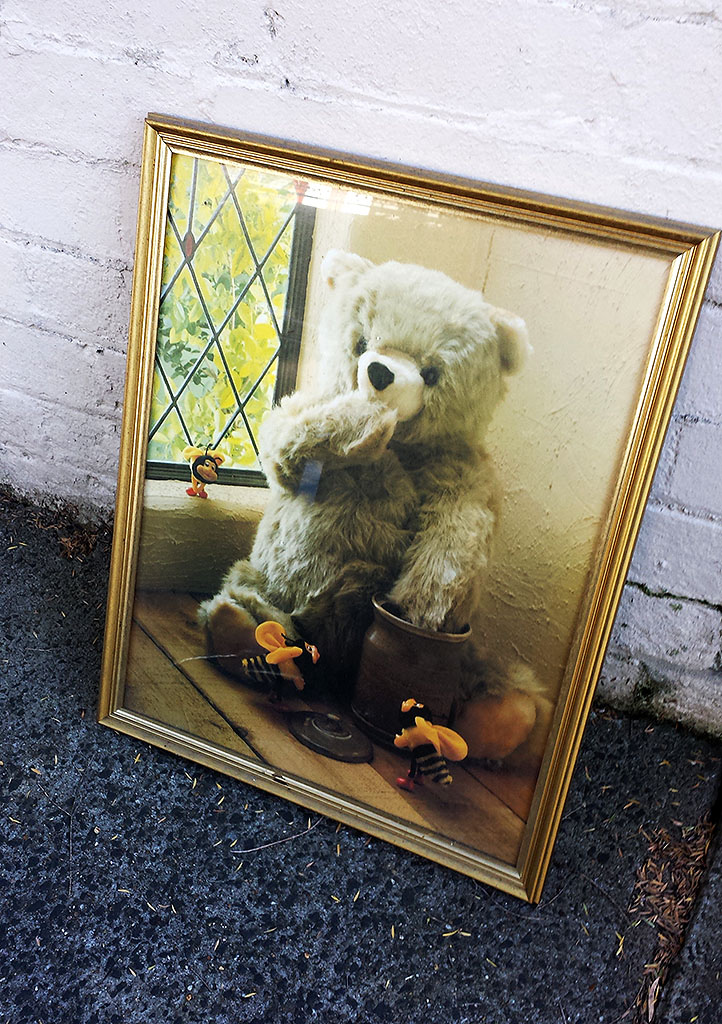Another teddy bear, although far fewer than last time. And where there was uncertainty before, there can be no doubt this time. This is art.
For the casual observer, this deceptively innocent tableau of a bear and three bees raises some intriguing questions, not least why the bees are looking so beseechingly at the bear, as if hoping for a drop of honey (assuming that is what is in the pot – the actual contents remain hidden from us) to fall their way.
Bees don’t typically collect honey. They collect nectar which is used to make honey. The fact that there is honey in the pot means it has already been harvested – or stolen if you prefer – from the hive.
So these bees are on a recovery mission to win back the honey. It is hard to see what their tactics might be from this point on, except perhaps to beguile the bear with cuteness. I have my doubts about the effectiveness of such an approach however. Just look at that bear’s eyes. Dead. Unblinking. That’s not the look of a bear who is about to succumb to special pleading.
As a result, the bees are reduced to the status of wretched onlookers watching the fruits of their labour being consumed by a more powerful interloper.
A case perhaps could be made for the bees having donated their honey to the bear in an act of astounding generosity, for whatever reason. I’m not buying it though. The honey is in the jar. Bees can’t do that. Quite clearly somebody else has put the honey in the jar from which the bear is now helping itself without a second thought. It is, in effect, a double theft, the thief appropriating that which has already been purloined.
One could argue then that the picture is an allegory for a world in which the powerful are able to take whatever they like for their own enjoyment – even that which has already been stolen – while the ‘workers’ (whose labour has been taken from them) are left with nothing. Beneath its charming appearance, this work suggests a powerful critique of the ‘winner-takes-all’ mentality which results in a society divided between the haves and have-nots.
Of course, we know nothing – and can infer very little – about the circumstances of the bear, how it came to be caught in the act, whether or not this is habitual, a recurring theft, or a one-off. Do we need to know such details in order to deepen our understanding of the picture or is it sufficient that we are left to fill in the blanks ourselves, positing potential scenarios and building a back story?
The point is that this picture, in order to arrive an emotional truth – something we can clearly read – relies on a fundamental lie. For a start, these are not real creatures, they are toys posed in a fictional encounter, a simulacrum of a meeting between a bear and bees which is fundamentally false. So while we might be tempted to read it as a representation of a narrative scene, a moment frozen in time, the truth of the ‘double theft’ is in fact the product of a double misrecognition: toys representing animals in what is clearly a staged ‘fake’ exchange.
We recognise what the picture is showing us (the theft of honey from bees by a bear) even though what we see – or think we see (a bear eating honey with bees) – is literally and obviously impossible.
Such is the way in which art works, speaking to us about an essential ‘truth’ by means of an obvious ‘lie’. As such, the truth of all art derives from its ability to convince us with a false representation, a construction that is more ‘real’ than reality.
View more dead art here.
